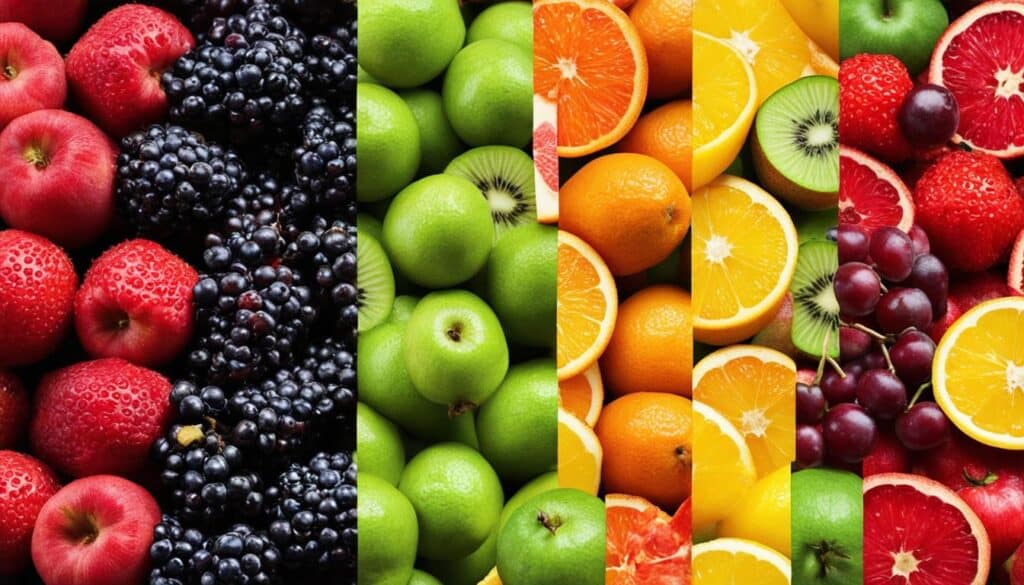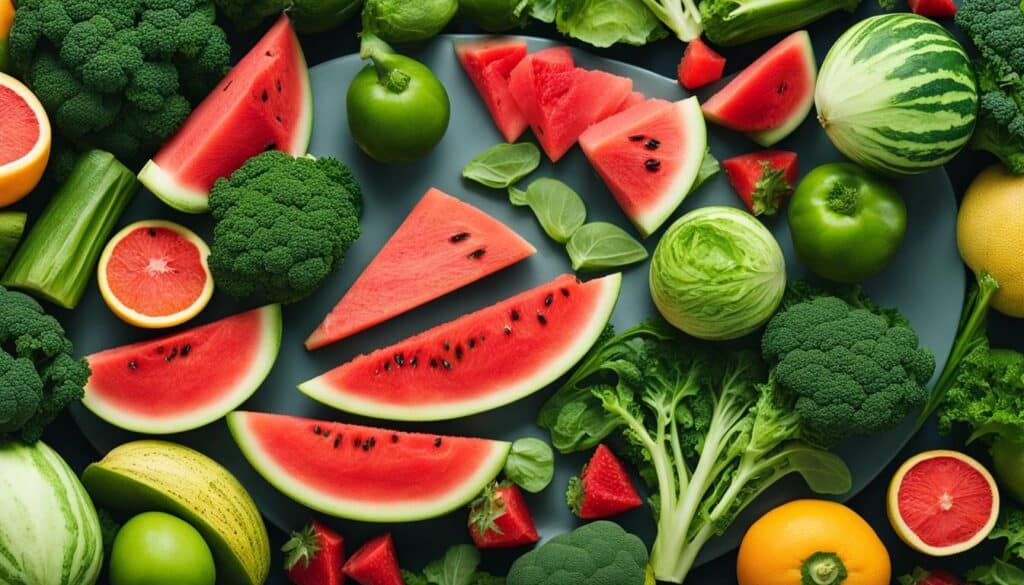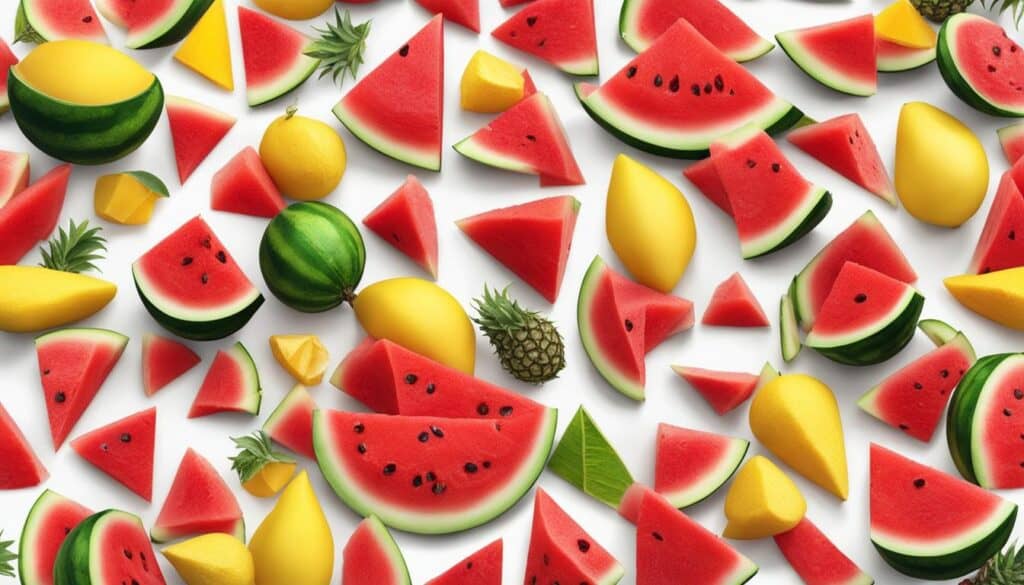Greetings! I’m excited to share some fascinating information about the acidity and alkalinity of fruits. You might be surprised to learn that not all fruits are alkaline-forming. In fact, some fruits that are commonly believed to be alkaline, such as pineapple, banana, oranges, and melons, are actually acid-forming due to their high sugar content. This can have significant implications for your health and well-being.
Most alkaline food charts classify fruits based on the Potential Renal Acid Load (PRAL) method, which focuses on the pH of the ash residue obtained from burning the food. However, this method does not take into consideration the sugar content of the fruit. Fruits with high fructose content can be damaging to the body, leading to weight gain, fatty liver disease, insulin resistance, inflammation, and other health issues.
So, which fruits are truly alkaline-forming? The top alkaline-forming fruits include lemon, lime, avocado, cucumber, tomato, grapefruit, and pomegranate. These fruits have a beneficial effect on the body’s pH level, promoting alkalinity and supporting overall health.
Key Takeaways:
- Not all fruits are alkaline-forming, despite common misconceptions.
- Fruits with high sugar content can be acid-forming and detrimental to health.
- The PRAL method, used to classify fruits, does not consider sugar content.
- Top alkaline-forming fruits include lemon, lime, avocado, cucumber, tomato, grapefruit, and pomegranate.
- Understanding the acidity and alkalinity of fruits is crucial for maintaining optimal health.
Understanding Alkaline-FORMING and Acid-FORMING Fruits
When it comes to classifying fruits as either alkaline or acidic, it’s crucial to focus on the effect they have on the body’s pH levels, rather than their own pH. Alkaline fruits are those that have an alkaline-forming effect on the body, while acid fruits have an acid-forming effect. Let’s take a closer look at these categories:
Alkaline-FORMING Fruits
The following fruits are considered alkaline-forming:
- Lemon
- Lime
- Avocado
- Cucumber
- Tomato
- Grapefruit
Acid-FORMING Fruits
On the other hand, these fruits are classified as acid-forming:
- Banana
- Pineapple
- Melons
- Grapes
- Oranges
- Berries
- Pears
- Passionfruit
- Kiwifruit
- Papaya
- Mango
Understanding the difference between alkaline-forming and acid-forming fruits can help you make informed choices about your diet and maintain a balanced pH level in your body.
| Fruit Type | Examples |
|---|---|
| Alkaline-FORMING Fruits | Lemon, Lime, Avocado, Cucumber, Tomato, Grapefruit |
| Acid-FORMING Fruits | Banana, Pineapple, Melons, Grapes, Oranges, Berries, Pears, Passionfruit, Kiwifruit, Papaya, Mango |
The Problem with Fructose in Fruits
Fructose, found in high amounts in many fruits, is a highly damaging sugar for the body. Unlike other sugars, fructose can only be metabolized by the liver, causing stress to the liver, pancreas, and other organs. It leads to weight gain, fatty liver disease, insulin resistance, inflammation, and increased hunger. Fructose in fruits can result in the storage of fat cells, uric acid formation, and an inability to stop eating.
It’s important to moderate fruit consumption and be aware of the high fructose content in certain fruits.
One way to better understand the fructose content in fruits is to refer to the table below:
| Fruit | Fructose Content (grams per 100g) |
|---|---|
| Apple | 6.3 |
| Banana | 5.9 |
| Orange | 2.9 |
| Pineapple | 3.8 |
| Grapes | 7.6 |
As you can see, fruits like apples, bananas, and grapes have a relatively high fructose content. While these fruits also provide essential nutrients, it’s important to consume them in moderation, especially if you have pre-existing health conditions like diabetes or metabolic syndrome.
Remember, a balanced diet is key, and it’s crucial to consider the overall sugar intake, including fructose, from various sources, not just fruits.
Alkaline Fruits and Acidic Fruits: The Real Classification
The classification of fruits as alkaline or acidic is misleading. Instead, it’s more accurate to classify them as alkaline-forming or acid-forming. Fresh alkaline-forming fruits include lemon, lime, avocado, cucumber, tomato, and grapefruit. Acid-forming fruits include banana, pineapple, melons, grapes, oranges, berries, pears, passionfruit, kiwifruit, papaya, and mango. It’s important to note that alkaline-forming fruits like lemons and limes may be acidic in nature but have an alkaline-forming effect on the body once metabolized.
While some fruits like lemons and limes may have an acidic taste, they have an alkaline-forming effect on the body once digested and metabolized. On the other hand, fruits like bananas and pineapples may taste sweet but have an acid-forming effect on the body. The key is to understand how fruits are metabolized and their impact on the body’s pH balance.”
It’s important to consider the overall effect a fruit has on the body’s pH rather than solely relying on its taste or acidity. The alkaline-forming fruits help maintain a balanced pH level, while acid-forming fruits can contribute to an acidic environment within the body.
To give you a visual representation of the alkaline and acid-forming fruits, here is a table showcasing some examples:
| Alkaline-Forming Fruits | Acid-Forming Fruits |
|---|---|
| Lemon | Banana |
| Lime | Pineapple |
| Avocado | Melons |
| Cucumber | Grapes |
| Tomato | Oranges |
| Grapefruit | Berries |
Understanding the classification of fruits as alkaline-forming or acid-forming is crucial for maintaining a balanced pH level in the body. Incorporating a variety of alkaline-forming fruits into your diet can help create an alkaline environment and support overall health.

It’s important to note that while fruits are beneficial for overall health, moderation is key. Balancing alkaline-forming and acid-forming fruits, along with other food choices, can contribute to a healthy and well-rounded diet.
The Importance of Maintaining an Alkaline pH Level
Our bodies have a natural pH level that determines the acidity or alkalinity of our bodily fluids. It is essential to maintain an alkaline pH level to promote optimal health and well-being. An acidic body, on the other hand, can increase the risk of various diseases, impair the immune system, promote the development of free radicals, and create a favorable environment for harmful viruses and bacteria.
Diet plays a significant role in determining the pH level of our bodies. Alkaline-forming foods contribute to an alkaline environment, while acid-forming foods contribute to acidity. By consuming more alkaline-forming foods and reducing the intake of acid-forming foods, we can help maintain a balanced pH level and support overall health.
Effects of an Acidic Body
When the body becomes too acidic, it can lead to a wide range of health issues. Some of the effects of an acidic body include:
- Increased risk of chronic diseases
- Impaired immune system function
- Promotion of free radicals
- Formation of kidney stones
- Favorable environment for harmful viruses and bacteria
By maintaining an alkaline pH level, we can mitigate these risks and promote a healthier internal environment.
The Role of Diet in pH Balance
Diet is a key factor in maintaining the pH balance of our bodies. Alkaline-forming foods help create an alkaline environment, while acid-forming foods contribute to acidity. Here are examples of both:
| Alkaline-forming foods | Acid-forming foods |
|---|---|
| Lemons | Processed meats |
| Cucumbers | Dairy products |
| Avocados | Refined grains |
| Leafy green vegetables | Sugar |
Striving for Alkalinity
To maintain an alkaline pH level and support overall health, it is recommended to incorporate more alkaline-forming foods into your diet, such as:
“Let food be thy medicine and medicine be thy food.” – Hippocrates
- Lemons
- Cucumbers
- Avocados
- Leafy green vegetables
By focusing on these alkaline-forming foods, you can create an environment within your body that promotes optimal health and well-being. Remember, maintaining an alkaline pH level is a lifelong commitment to your health.

Alkaline Food Test: How to Determine if a Food is Acid or Alkaline Forming
When it comes to determining if a food is acid or alkaline forming, there are two main methods to consider. The first method is called the Potential Renal Acid Load (PRAL), which measures the pH of the ash residue obtained by burning the food. However, this method does not take into account the sugar content of the food, which is crucial in determining the actual acidity or alkalinity of the food once metabolized by the body.
The second method focuses on the effect that the food has on the body’s pH level after consumption. This method takes into consideration various factors that determine whether a food is alkaline or acid forming.
Alkaline-forming foods are those that have an alkalizing effect on the body. These foods typically possess certain characteristics such as freshness, high mineral content (e.g., calcium and potassium), low sugar content, high water content, and a green color. On the other hand, acid-forming foods are those that contribute to acidity in the body and often contain sugar, yeast, fermented ingredients, as well as dairy and refined foods.
| Characteristics of Alkaline-Forming Foods | Characteristics of Acid-Forming Foods |
|---|---|
| Freshness | Sugar content |
| High mineral content (e.g., calcium, potassium) | Yeast |
| Low sugar content | Fermentation |
| High water content | Dairy |
| Green color | Refined foods |
By understanding these characteristics and incorporating more alkaline-forming foods into our diet while reducing the consumption of acid-forming foods, we can help maintain a balanced pH level in the body, promoting overall health and well-being.
The Importance of Chlorophyll-Rich Foods in Maintaining an Alkaline Body
Foods rich in chlorophyll play a vital role in maintaining an alkaline body. One of the key benefits of chlorophyll is its ability to promote cellular regeneration, detoxification, and the production of red blood cells. By incorporating chlorophyll-rich foods into your diet, you can support the alkaline environment necessary for optimal health.
One group of alkaline-forming foods that are rich in chlorophyll are dark green leafy vegetables. These include spinach, kale, collard greens, and Swiss chard. Dark green leafy vegetables not only provide an abundance of chlorophyll but are also packed with essential vitamins, minerals, and fiber that contribute to overall well-being.
Additionally, whole grains such as amaranth, buckwheat, millet, quinoa, and wild rice are also alkaline-forming. These grains are excellent sources of nutrients and can help balance the body’s pH levels.
Certain fruits also have an alkaline effect on the body once they are digested and metabolized. Some examples of these fruits include grapefruit, lemons, limes, mangos, papayas, cranberries, plums, prunes, and sour cherries.
| Chlorophyll-Rich Foods | Alkaline-Forming Nature |
|---|---|
| Dark green leafy vegetables (e.g., spinach, kale, collard greens, Swiss chard, etc.) | Yes |
| Whole grains (e.g., amaranth, buckwheat, millet, quinoa, wild rice, etc.) | Yes |
| Fruits (e.g., grapefruit, lemons, limes, mangos, papayas, cranberries, plums, prunes, sour cherries, etc.) | Yes |
By incorporating these chlorophyll-rich foods into your diet, you can support the alkaline state of your body and promote overall well-being.

Remember to consult with a healthcare professional or registered dietitian for personalized dietary advice.
Acid-Forming Foods to Avoid
Maintaining an alkaline body requires avoiding acid-forming foods. These foods contribute to an overly acidic body pH, which can lead to chronic diseases and health issues. By reducing the consumption of acid-forming foods, you can promote a more alkaline environment in your body. Here are some acid-forming foods to avoid:
- Processed Foods: Foods that undergo extensive processing, such as white rice, white pasta, white flour, and white sugar, are highly acid-forming. These refined foods lack essential vitamins, minerals, and fiber, contributing to acidity in the body.
- Meat and Poultry: Animal-based products like meat and poultry are acid-forming due to their high protein content. While they provide essential nutrients, excessive consumption can lead to increased acidity in the body.
- Dairy Products: Dairy products like butter, margarine, cheese, and milk are acid-forming. They contain high amounts of protein and fat, contributing to an acidic body pH.
- Refined Foods: Foods that have undergone refining processes, such as refined grains and sugars, are acid-forming. These include products made with refined flours and added sugars, which can disrupt the body’s pH balance.
It’s important to note that high sugar content, yeast, and fermentation can also contribute to acid formation in the body. By avoiding these acid-forming foods and opting for more alkaline-forming options, you can support overall health and well-being.

The Best & Worst Acidic Fruits: A Guide for Moderation
When it comes to the acidity or alkalinity of fruits, the sugar content plays a significant role. Certain fruits with high sugar content are considered high-sugar fruits and should be consumed in moderation. On the other hand, low-sugar fruits are preferable choices. Let’s explore the best and worst acidic fruits and learn how to incorporate them into a balanced diet.
High-sugar fruits:
- Pineapple
- Apple
- Oranges
- Bananas
Low-sugar fruits:
- Berries
- Melons
While high-sugar fruits may taste delicious, it’s important to consume them in moderation due to their potential negative effects on the body. The high sugar content can contribute to weight gain, insulin resistance, and other health issues. On the other hand, low-sugar fruits are a better choice as they provide essential nutrients without excessive sugar.
To maintain a healthy intake of fruits, it’s recommended to follow the guideline of consuming 1-2 pieces of fruit per day. Additionally, it’s important to avoid fruit juices and smoothies, as they can often contain high amounts of sugars and lack the fiber found in whole fruits. Dried fruits should also be consumed sparingly due to their concentrated sugar content.
All fruits, including high-sugar fruits, can be enjoyed as part of a balanced diet. The key is moderation and being mindful of your overall sugar intake. By incorporating a variety of fruits into your diet and following the guidelines for maintaining an optimal pH level, you can enjoy the benefits of fruits while keeping your sugar consumption in check.

Remember, a healthy and balanced diet is about making smart choices and being aware of the nutritional content of the foods you consume. By understanding the sugar content of fruits and incorporating them in moderation, you can maintain a well-rounded diet that supports your overall health and well-being.
Conclusion
Maintaining an optimal pH balance in the body is crucial for overall health and the prevention of disease. By understanding the difference between alkaline-forming and acid-forming foods, particularly fruits, we can make informed choices about our diet. While some fruits may be acidic in nature, it’s important to consider their effect on the body after consumption.
By following a diet that includes alkaline-forming foods like dark green leafy vegetables, low-sugar fruits, and whole grains, we can support an alkaline environment in our bodies. This means incorporating foods like spinach, kale, broccoli, lemon, lime, grapefruit, and cucumber into our daily meals.
On the other hand, it’s crucial to limit or avoid processed foods, meat, dairy, and high-sugar fruits, which can contribute to an acidic pH level. By making these dietary adjustments, we can achieve an optimal diet and pH balance, promoting overall well-being and reducing the risk of chronic diseases.
FAQ
Are all fruits acidic or alkaline?
Not all fruits are acidic or alkaline. The classification of fruits depends on their effect on the body’s pH level after consumption.
How do acidic fruits differ from alkaline fruits?
Acidic fruits have an acid-forming effect on the body, while alkaline fruits have an alkaline-forming effect.
What are the top alkaline-forming fruits?
The top alkaline-forming fruits are lemon, lime, avocado, cucumber, tomato, grapefruit, and pomegranate.
What are the top acid-forming fruits?
The top acid-forming fruits include banana, pineapple, melons, grapes, oranges, berries, pears, passionfruit, kiwifruit, papaya, and mango.
What is the problem with fructose in fruits?
Fructose, found in high amounts in many fruits, is a damaging sugar that can lead to weight gain, fatty liver disease, insulin resistance, inflammation, and increased hunger.
How can I determine if a food is acid or alkaline forming?
There are two methods: the first measures the pH of the ash residue obtained by burning the food, and the second focuses on the effect of the food on the body’s pH level after consumption.
What are some alkaline-forming foods?
Alkaline-forming foods include dark green leafy vegetables, low-sugar fruits, whole grains like amaranth, buckwheat, millet, quinoa, and wild rice.
What are some acid-forming foods to avoid?
Acid-forming foods to avoid include processed foods, meat, dairy, refined foods, high-sugar fruits, and foods with yeast or fermentation.
How much fruit should I consume?
It is recommended to consume 1-2 pieces of fruit per day and to avoid fruit juices, smoothies, and dried fruits.
What is the importance of maintaining an alkaline pH level?
Maintaining an alkaline pH level supports overall health, prevents disease, and provides an optimal environment for the body’s functions.





Leave a Reply